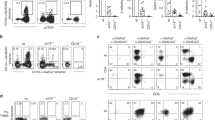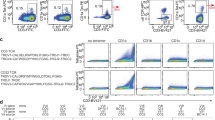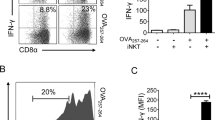Abstract
Natural killer T cells (NKT cells) are divided into type I and type II subsets on the basis of differences in their T cell antigen receptor (TCR) repertoire and CD1d-antigen specificity. Although the mode by which type I NKT cell TCRs recognize CD1d-antigen has been established, how type II NKT cell TCRs engage CD1d-antigen is unknown. Here we provide a basis for how a type II NKT cell TCR, XV19, recognized CD1d-sulfatide. The XV19 TCR bound orthogonally above the A′ pocket of CD1d, in contrast to the parallel docking of type I NKT cell TCRs over the F′ pocket of CD1d. At the XV19 TCR–CD1d-sulfatide interface, the TCRα and TCRβ chains sat centrally on CD1d, where the malleable CDR3 loops dominated interactions with CD1d-sulfatide. Accordingly, we highlight the diverse mechanisms by which NKT cell TCRs can bind CD1d and account for the distinct antigen specificity of type II NKT cells.
This is a preview of subscription content, access via your institution
Access options
Subscribe to this journal
Receive 12 print issues and online access
$209.00 per year
only $17.42 per issue
Buy this article
- Purchase on Springer Link
- Instant access to full article PDF
Prices may be subject to local taxes which are calculated during checkout





Similar content being viewed by others
References
Godfrey, D.I., MacDonald, H.R., Kronenberg, M., Smyth, M.J. & Van Kaer, L. NKT cells: what's in a name? Nat. Rev. Immunol. 4, 231–237 (2004).
Terabe, M. & Berzofsky, J.A. NKT cells in immunoregulation of tumor immunity: a new immunoregulatory axis. Trends Immunol. 28, 491–496 (2007).
Joyce, S., Girardi, E. & Zajonc, D.M. NKT cell ligand recognition logic: molecular basis for a synaptic duet and transmission of inflammatory effectors. J. Immunol. 187, 1081–1089 (2011).
Godfrey, D.I. et al. Antigen recognition by CD1d-restricted NKT T cell receptors. Semin. Immunol. 22, 61–67 (2010).
Borg, N.A. et al. CD1d-lipid-antigen recognition by the semi-invariant NKT T-cell receptor. Nature 448, 44–49 (2007).
Li, Y. et al. The Va14 invariant natural killer T cell TCR forces microbial glycolipids and CD1d into a conserved binding mode. J. Exp. Med. 207, 2383–2393 (2010).
López-Sagaseta, J., Sibener, L.V., Kung, J.E., Gumperz, J. & Adams, E.J. Lysophospholipid presentation by CD1d and recognition by a human natural killer T-cell receptor. EMBO J. 31, 2047–2059 (2012).
Pellicci, D.G. et al. Recognition of β-linked self glycolipids mediated by natural killer T cell antigen receptors. Nat. Immunol. 12, 827–833 (2011).
Yu, E.D., Girardi, E., Wang, J. & Zajonc, D.M. Cutting edge: structural basis for the recognition of β-linked glycolipid antigens by invariant NKT cells. J. Immunol. 187, 2079–2083 (2011).
Scott-Browne, J.P. et al. Germline-encoded recognition of diverse glycolipids by natural killer T cells. Nat. Immunol. 8, 1105–1113 (2007).
Mallevaey, T. et al. A molecular basis for NKT cell recognition of CD1d-self-antigen. Immunity 34, 315–326 (2011).
Mallevaey, T. et al. T cell receptor CDR2β and CDR3β loops collaborate functionally to shape the iNKT cell repertoire. Immunity 31, 60–71 (2009).
Matulis, G. et al. Innate-like control of human iNKT cell autoreactivity via the hypervariable CDR3β loop. PLoS Biol. 8, e1000402 (2010).
Patel, O. et al. Vb2 natural killer T cell antigen receptor-mediated recognition of CD1d-glycolipid antigen. Proc. Natl. Acad. Sci. USA 108, 19007–19012 (2011).
Pellicci, D.G. et al. Differential recognition of CD1d-α-galactosyl ceramide by the Vβ8.2 and Vβ7 semi-invariant NKT T cell receptors. Immunity 31, 47–59 (2009).
Adams, E.J. & Lopez-Sagaseta, J. The immutable recognition of CD1d. Immunity 34, 281–283 (2011).
Blomqvist, M. et al. Multiple tissue-specific isoforms of sulfatide activate CD1d-restricted type II NKT cells. Eur. J. Immunol. 39, 1726–1735 (2009).
Jahng, A. et al. Prevention of autoimmunity by targeting a distinct, noninvariant CD1d-reactive T cell population reactive to sulfatide. J. Exp. Med. 199, 947–957 (2004).
Park, S.H. et al. The mouse CD1d-restricted repertoire is dominated by a few autoreactive T cell receptor families. J. Exp. Med. 193, 893–904 (2001).
Arrenberg, P., Halder, R., Dai, Y., Maricic, I. & Kumar, V. Oligoclonality and innate-like features in the TCR repertoire of type II NKT cells reactive to a β-linked self-glycolipid. Proc. Natl. Acad. Sci. USA 107, 10984–10989 (2010).
Cardell, S. et al. CD1-restricted CD4+ T cells in major histocompatibility complex class II-deficient mice. J. Exp. Med. 182, 993–1004 (1995).
Bai, L. et al. Lysosomal recycling terminates CD1d-mediated presentation of short and polyunsaturated variants of the NKT cell lipid antigen αGalCer. Proc. Natl. Acad. Sci. USA 106, 10254–10259 (2009).
Im, J.S. et al. Kinetics and cellular site of glycolipid loading control the outcome of natural killer T cell activation. Immunity 30, 888–898 (2009).
Sullivan, B.A. et al. Mechanisms for glycolipid antigen-driven cytokine polarization by Vα14i NKT cells. J. Immunol. 184, 141–153 (2010).
Wun, K.S. et al. A molecular basis for the exquisite CD1d-restricted antigen specificity and functional responses of natural killer T cells. Immunity 34, 327–339 (2011).
Godfrey, D.I., Rossjohn, J. & McCluskey, J. The fidelity, occasional promiscuity, and versatility of T cell receptor recognition. Immunity 28, 304–314 (2008).
Zajonc, D.M. et al. Structural basis for CD1d presentation of a sulfatide derived from myelin and its implications for autoimmunity. J. Exp. Med. 202, 1517–1526 (2005).
Monzon-Casanova, E. et al. CD1d expression in Paneth cells and rat exocrine pancreas revealed by novel monoclonal antibodies which differentially affect NKT cell activation. PLoS ONE 5, e13089 (2010).
Burdin, N. et al. Structural requirements for antigen presentation by mouse CD1. Proc. Natl. Acad. Sci. USA 97, 10156–10161 (2000).
Brennan, P.J. et al. Invariant natural killer T cells recognize lipid self antigen induced by microbial danger signals. Nat. Immunol. 12, 1202–1211 (2011).
Exley, M.A. et al. Cutting edge: A major fraction of human bone marrow lymphocytes are Th2-like CD1d-reactive T cells that can suppress mixed lymphocyte responses. J. Immunol. 167, 5531–5534 (2001).
Patel, O. et al. NKT TCR recognition of CD1d-α-C-galactosylceramide. J. Immunol. 187, 4705–4713 (2011).
Uldrich, A.P. et al. A semi-invariant Vα10+ T cell antigen receptor defines a population of natural killer T cells with distinct glycolipid antigen-recognition properties. Nat. Immunol. 12, 616–623 (2011).
Aspeslagh, S. et al. Galactose-modified iNKT cell agonists stabilized by an induced fit of CD1d prevent tumour metastasis. EMBO J. 30, 2294–2305 (2011).
Girardi, E. et al. Unique interplay between sugar and lipid in determining the antigenic potency of bacterial antigens for NKT cells. PLoS Biol. 9, e1001189 (2011).
Wang, J. et al. Lipid binding orientation within CD1d affects recognition of Borrelia burgorferi antigens by NKT cells. Proc. Natl. Acad. Sci. USA 107, 1535–1540 (2010).
Wun, K.S. et al. A minimal binding footprint on CD1d-glycolipid is a basis for selection of the unique human NKT TCR. J. Exp. Med. 205, 939–949 (2008).
Borg, N.A. et al. The CDR3 regions of an immunodominant T cell receptor dictate the 'energetic landscape' of peptide-MHC recognition. Nat. Immunol. 6, 171–180 (2005).
Garcia, K.C. et al. Structural basis of plasticity in T cell receptor recognition of a self peptide-MHC antigen. Science 279, 1166–1172 (1998).
Hahn, M., Nicholson, M.J., Pyrdol, J. & Wucherpfennig, K.W. Unconventional topology of self peptide-major histocompatibility complex binding by a human autoimmune T cell receptor. Nat. Immunol. 6, 490–496 (2005).
Gras, S. et al. The shaping of T cell receptor recognition by self-tolerance. Immunity 30, 193–203 (2009).
Gras, S. et al. A structural basis for varied αβ TCR usage against an immunodominant EBV antigen restricted to a HLA-B8 molecule. J. Immunol. 188, 311–321 (2012).
Chang, D.H. et al. Inflammation associated lysophospholipids as ligands for CD1d restricted T cells in human cancer. Blood 112, 1308–1316 (2008).
Dieudé, M. et al. Cardiolipin binds to CD1d and stimulates CD1d-restricted γδ T cells in the normal murine repertoire. J. Immunol. 186, 4771–4781 (2011).
Van Rhijn, I. et al. CD1d-restricted T cell activation by nonlipidic small molecules. Proc. Natl. Acad. Sci. USA 101, 13578–13583 (2004).
Tikhonova, A.N. et al. αβ T cell receptors that do not undergo major histocompatibility complex-specific thymic selection possess antibody-like recognition specificities. Immunity 36, 79–91 (2012).
Cochet, M. et al. Molecular detection and in vivo analysis of the specific T cell response to a protein antigen. Eur. J. Immunol. 22, 2639–2647 (1992).
Pannetier, C. et al. The sizes of the CDR3 hypervariable regions of the murine T-cell receptor β chains vary as a function of the recombined germ-line segments. Proc. Natl. Acad. Sci. USA 90, 4319–4323 (1993).
Casanova, J.L., Romero, P., Widmann, C., Kourilsky, P. & Maryanski, J.L. T cell receptor genes in a series of class I major histocompatibility complex-restricted cytotoxic T lymphocyte clones specific for a Plasmodium berghei nonapeptide: implications for T cell allelic exclusion and antigen-specific repertoire. J. Exp. Med. 174, 1371–1383 (1991).
Kabsch, W. Automatic processing of rotation diffraction data from crystals of initially unknown symmetry and cell constants. J. Appl. Cryst. 26, 795–800 (1993).
Collaborative Computational Project. CCP4 The CCP4 suite: programs for protein crystallography. Acta Crystallogr. D Biol. Crystallogr. 50, 760–763 (1994).
Bricogne, G. et al. autoBUSTER, Version 1.6.0 (Global Phasing, Cambridge, United Kingdom, 2011).
DeLano, W.L. The PyMOL Molecular Graphics System (DeLano Scientific, San Carlos, California, 2002).
Acknowledgements
We thank the staff at the MX2 beamline of the Australian synchrotron for assistance with data collection and Monash Macromolecular Crystallisation Facility for crystallization experiments. Supported by the National Health and Medical Research Council of Australia (D.I.G. and J.R.), the Australian Research Council, the Cancer Council of Victoria, the US National Institutes of Health (AI090450 and AI092108 to L.G.), the Swedish Research Council (S.L.C.), the Swedish Cancer Society (S.L.C.) and Monash University (S.G. and J.R.).
Author information
Authors and Affiliations
Contributions
O.P., D.G.P. and S.G. generated and analyzed data; M.L.S.-R., A.J.C., A.T., A.P.U., J.L.N., T.M. and L.G. generated data; S.L.C. provided the XV19 and VIII24 cells; and D.I.G. and J.R. together led the investigation, devised the project, analyzed the data and wrote the manuscript.
Corresponding authors
Ethics declarations
Competing interests
The authors declare no competing financial interests.
Supplementary information
Supplementary Text and Figures
Supplementary Figures 1–5 and Supplementary Table 1 (PDF 3022 kb)
Rights and permissions
About this article
Cite this article
Patel, O., Pellicci, D., Gras, S. et al. Recognition of CD1d-sulfatide mediated by a type II natural killer T cell antigen receptor. Nat Immunol 13, 857–863 (2012). https://doi.org/10.1038/ni.2372
Received:
Accepted:
Published:
Issue Date:
DOI: https://doi.org/10.1038/ni.2372
This article is cited by
-
Chronic brain damage in HIV-infected individuals under antiretroviral therapy is associated with viral reservoirs, sulfatide release, and compromised cell-to-cell communication
Cellular and Molecular Life Sciences (2023)
-
Current Developments in the Preclinical and Clinical use of Natural Killer T cells
BioDrugs (2023)
-
A single-domain bispecific antibody targeting CD1d and the NKT T-cell receptor induces a potent antitumor response
Nature Cancer (2020)
-
Distinct CD1d docking strategies exhibited by diverse Type II NKT cell receptors
Nature Communications (2019)
-
CD1c caves in on lipids
Nature Immunology (2018)



